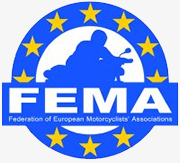The Federation of European Motorcyclists Associations – FEMA gives an insight from inside the Motorcycle Working Group Meeting (MCWG) held in Brussels on Friday 16th September.
Our own report – Moving The Goal Posts – Click Here – says, when we similarly reported that: “We have to agree with ACEM – at the MCWG meeting on Friday, their representative told the Commission and members with regards to the timetable for implementing the proposed regulations that the revised Commission proposal was “a Nightmare Scenario” and commented that the Commission was “changing the rules in the middle of the game.
At Right To Ride, our view is that not only have they changed the rules in the middle of the game, but they have also moved the goal posts!”
New type approval insights from the European Commission
20th September 2011
 As the European Parliament and the Council of Ministers start looking into the new type-approval regulation, its original author, the European Commission, tries to throw in some last-minute changes and revealed some interesting insights in anti-tampering research. FEMA attended the stakeholders’ meeting on Friday, and deciphers the legal and the technical for riders.
As the European Parliament and the Council of Ministers start looking into the new type-approval regulation, its original author, the European Commission, tries to throw in some last-minute changes and revealed some interesting insights in anti-tampering research. FEMA attended the stakeholders’ meeting on Friday, and deciphers the legal and the technical for riders.
The Commission treated representatives of the Member States and interest groups to additional information on its regulation on the type-approval of motorcycles on Friday, during a Motorcycle Working Group Meeting (MCWG) in Brussels. The working group, a platform for information circulation and stakeholder input, had not convened since January, and its members awaited eagerly the results of investigations on technical aspects of the regulation, mostly on durability and engine tampering, commissioned for the occasion.
The new type-approval regulation, a recast of existing directives with additional requirements in terms of safety equipment, environmental performance and market surveillance, was presented late last year and has been a point of interest for FEMA and its members ever since. The current draft, proposed by the Commission, is now under scrutiny of the Parliament and the Council of Ministers, who can amend the text before taking a final vote that will turn it into law. Until then, everything is possible.
Untimely afterthoughts
The general principle in European Union law is that the European Commission is in charge of drafting proposals for new laws (directives and regulations), which are then handed to European Parliament and Council of Ministers for amendments and approval by vote. Once the text lands on the MEPs’ desks, it ceases to be the Commission’s brainchild and starts a life of its own.
This is why it came as a surprise to everyone involved that the Commission forwarded to the Council of Ministers a “clarification” last week, in the form of an updated calendar for the implementation of emissions control measures, different from the proposal currently discussed. The new suggestion basically moves forward by one year all the dates for the introduction of Euro 3 and Euro 4 emission regulations for motorcycles.
The motorcycle industry promptly reacted, claiming that the Commission is “changing the rules in the middle of the game”. ACEM, the association of motorcycle manufacturers, complained from the beginning that the original calendar for the introduction of the various environmental (on-board diagnostics, durability, CO2 labelling, sound levels) and safety (automatic headlamps on, ABS/CBS) requirements was unrealistic, extremely tight, and would result in high adaptation costs for manufacturers.
The Commission’s latest “clarification”, halfway through the legislative process, is apparently even more threatening, prompting ACEM to call it a “nightmare scenario”. An example: all motorcycles put up for registration by January 2014 should comply with Euro 3, the technical details of which are expected to be published by the Commission… in December 2012, at best! This would leave all motorcycle manufacturers just over one year to design, develop and put in production new engines and new motorcycles, while selling their entire stock of previous-generation vehicles.
Read Full Article on Right To Ride EU – Click Here


